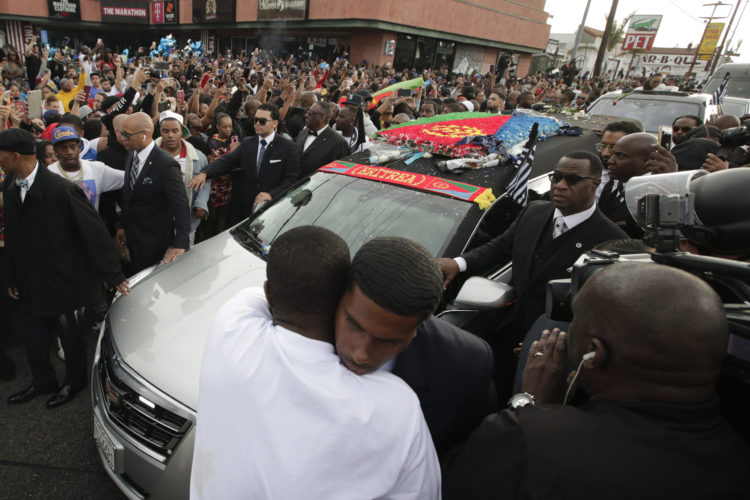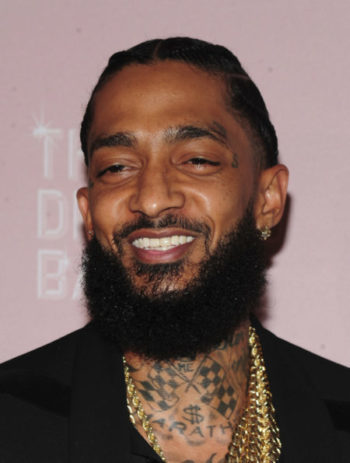
A hearse carrying the casket of slain rapper Nipsey Hussle passes through a dense crowd in Los Angeles on April 11, 2019. The 25-mile procession traveled through the streets of South Los Angeles after his memorial service, including a trip past Hussle's clothing store, The Marathon, where he was gunned down March 31. A year after Hussle's death, his popularity and influence are as strong as ever. He won two posthumous Grammys in January, he remains a favorite of his hip-hop peers and his death has reshaped his hometown of Los Angeles in some unexpected ways

Los Angeles Times reporter Angel Jennings
In recent months, Jennings’ focus has been on the devastation that covid has brought to a community already challenged by racism, violence and poverty. Among her stories: the narrative of a nurse who watched, through a shield, as her father died of Covid-19, how the pandemic could end a long-fought renaissance in South L.A., and the rise of underground salons and barbershops.
And of course now, she monitors how racial justice demonstrations across the country play out in South L.A., which was often the site of some of America’s most significant protests.
Her stories range from breaking news to data-based pieces to step-back perspectives. But she often is writing about sensitive topics, and interviewing people during intensely emotional times. We reached out to Jennings for tips on how to approach intimate stories, especially when confronted by mistrust, trauma and social distancing. Her comments have been edited for length and clarity.
On interviewing someone who has just lost a loved one:
I don’t launch heavy into journalism mode. I’m having a conversation with someone. I’m trying to get people to trust me with their most intimate details in life. I am listening to them and letting them lead the conversation. Then I’ll go back and ask them more detail on something.
With any of these stories where you’re writing about trauma, it’s important to not re-traumatize the person you’re interviewing. It’s important that you act like you’ve walked into a party that maybe you didn’t get an invitation to. You need to earn the right to be there. It’s a privilege that they’re opening you up to their world, they do not have to grant you this access.
So it’s important to take breaks during the conversation, check in on them, ask them if they’re okay. As a reporter you are supposed to be unbiased, but that does not mean you cannot be human. You can allow yourself to feel human emotions if you’re feeling sad by what they say. If It reminds you of something, it’s okay to reveal that.
I actually share my experiences with the people I’m interviewing. When I wrote the story about the nurse who watched her dad die, I had an aunt who had just passed away from the coronavirus. So I shared it: I just lost somebody. We didn’t get a chance to say goodbye. What was that like for you? Were you able to say goodbye in the traditional way? And they opened up.
When I was talking to Nipsey Hussle’s brother, I shared some of myself with him and other people I interviewed. We’re humans and I don’t think we have to be so stoic all the time. When you allow yourself to feel with the people you’re interviewing and kind of channel that feeling in your questioning, and then in your writing, you pour some of the emotions that you’re feeling into your work. That’s what resonates the most.
So I try to put myself in their shoes — digesting all this information someone gives you, absorbing all their feelings. You’re putting yourself in their bodies and you’re like, this is traumatizing, and if I’m feeling this then I’m able to get how their feelings are transmitted through me and I’m trying to put it down in words. I feel like this is where the magic happens.
On structure. A few days after Hussle’s death, Jennings interviewed his parents and girlfriend. The story was tight and the structure simple: a brief set-up followed by a series of quotes.
Nipsey died on a Sunday. The vigil was Monday. And I talked to Nipsey’s brother on Tuesday. I had called him to confirm certain details. And he’s like, “Oh, I’m with the family now. Do you want to talk to my mom? Do you want to talk to Lauren? Do you want to talk to my dad?” So I’m on a very pressing deadline. The editors were on me to have this story in by noon and Nipsey’s brother is passing around the phone. And so I’m like, “What do I do with these interviews?” I wanted to put them in the story, but the story had to go up.” So we created a quote story. And it worked because people read it was just like they were hearing the family’ voices.
On being in the community you cover:
I’ve been covering South LA for eight years now.
With the story about the nurse who watched her father die, she told me: “I decided to let you come to this because you’re a black woman….because I just felt that you would be able to tell my story because you look like us, because you experience the things we experience.” After the story ran, she told me that mattered; they got other media requests and ignored them.
I think, by and large, representation matters. Sometimes people feel more comfortable with people who look like them, or remind them of family. Even when I was talking to Nipsey Hussle’s brother, he said it was like talking to family. I think sometimes we’ve got to take off our journalist hat and just be people.

Nipsey Hussle at the 2018 Diamond Ball in New York City, September 13, 2018
On interviewing by phone:
I talked to Hussle’s brother, Samiel, while he was running errands out in the community. I could hear him sniffling as people were talking to him about his brother; I’m hearing them say “I’m sorry for your loss and other stuff.” So we’re just talking as he goes through his day. Then (he) tells me how he was there trying to save Nipsey’s life and was performing CPR. This conversation lasted many hours on the phone.
I kept saying, “We want to take photos of you guys. If you want us to come and interview you…” And he was like, “No, no, no, we’re good. We can’t. There’s no way we could take a photo right now — we’re missing a big part of our family.” And I asked, “OK, do you want to do the interview in person?” He’s like, “No, I’m good right here.”
Again, it’s meeting people where they are and asking for details so when you’re writing the story, you can make readers feel like they are there. So if I can’t be in the room with someone, I’m asking them, “Where are you sitting? Who’s there? What do you see on your wall?”
I just can’t stress this enough: As journalists, we’re told to be aggressive and try every angle to pursue a story and to get people to talk. But when we are dealing with issues of trauma, whether it’s a mass shooting, recovering from an earthquake or losing someone, you have to put on the baby gloves and be gentle.
On covering the death of Channel Jackson’s father at a distance:
I was invited to (the father’s funeral) and I was going to go, but my editor told me to watch it on live stream. I was in the parking lot watching them go into the funeral home. I was outside, probably like 40 feet away. I watched the funeral in my car, on my computer, and then I would run up to people and get their information real quick and tell them I’d call them later. And then I’d get back into my car.
On getting details. Jennings included careful details in her piece about the nurse, including this: “She carefully pressed the edges of an N-95 mask until it molded to her face.”
Channel (the nurse) was describing how she went into the ICU to see her dad. I asked her, “How did you prepare?” She told me she put on double gloves, and a face mask and a shield. So I just asked, “What kind of mask? How did you put it on?”
On writers who inspire her:
Eli Slaslow, Washington Post: He really knows how to bring you into a person’s pain
Terrence McCoy, Washington Post: Diving into the nuance of daily life
Corina Knoll, New York Times: Metaphors and similes inspire better descriptive writing
John Eligon, New York Times: His way of picking out detail and playing with structure
Rachael L. Kelley is a a Boston University graduate student studying journalism. American born and raised in South Africa, she aspires to cover trauma and underrepresented communities.
